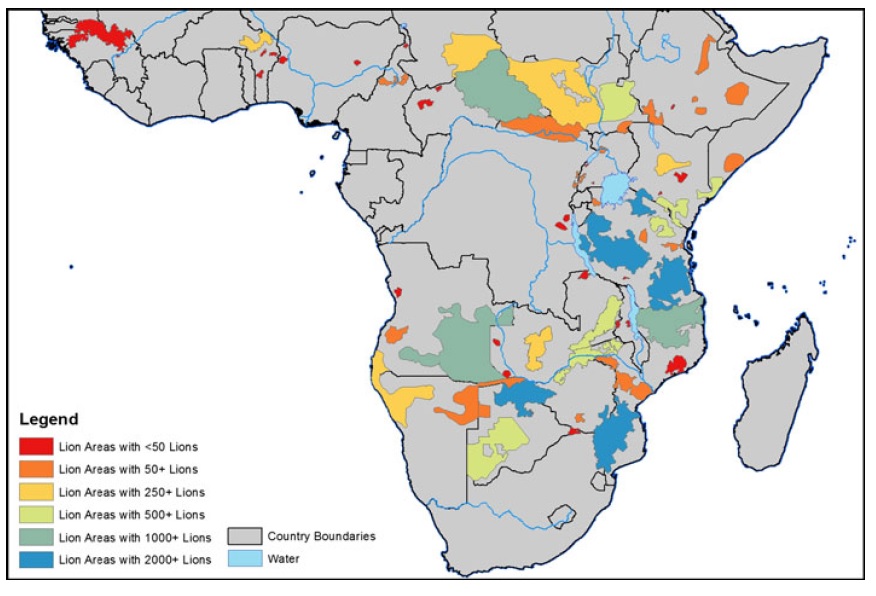Estimates suggest that today there are around 32,000 to 35,000 lions left. Sixty years ago this figure was somewere between 400,000 and 500,000, so in a lifetime we have seen a decline of 90 percent or more. Over that period the lion population in India (Panthera leo persica) has clung on and grown from just under 200 animals to about 350 – 400 animals today (from a low in the 1890s of about 20 individuals). Even in the 1940s lions were observed as far west as Iran but the entire Middle East no longer is home to these animals. Over this period the North African population has also dissappeared (with the last sightings in the late 1950s).
Worse still, the remaining bulk of population in sub-saharan Africa (see figure below) is patchy and sometimes involves tiny micropopulations, particularly in Central and West Africa, which could easily follow the fate of Middle Eastern and North African populations.
Reading
Black SA, Fellous A, Yamaguchi N, Roberts DL (2013) Examining the Extinction of the Barbary Lion and Its Implications for Felid Conservation. PLoS ONE 8(4): e60174. doi:10.1371/journal.pone.0060174
Riggio, J., Jacobson, A., Dollar, L. et al. (2012) The size of savannah Africa: a lion’s (Panthera leo) view.Biodiversity Conservation. DOI 10.1007/s10531-012-0381-4
http://www.livingwithlions.org/AnnualReports/2006-Lion-killing-in-Amboseli-Tsavo-ecosystem.pdf


Feel free to ask more questions!
Well , I’ll be sure to follow the news!
Can I ask you a more interesting questions for me?
These are two good questions each of which are worthy of a full blog article. The current status of the captive lion population is improving with new breeding pairs and new cubs produced in European zoos. As for introducing big cat species (or subspecies) as ‘analogues’ in ecosystems where the original endemic species is extict – well this is a very current topic. Keep an eye on the site and I will post something soon. Thanks for your interest and insights – spread the word!
“The good news is that this captive-breedng work is progressing – after many years of neglect. So things are on the move again!”
Very nice to hear it! my question is : Do you know how many expected animals are in captive now?
And,did you think about the reintroduction this lions in South Africa? This areas are in protection,and they have the same ecosistems.
Hope for the fast answer again)
Yes, getting all people to support conservation is critical – and very important when we consider large (dangerous) carnivores whose presence will have a real impact on people living in the vicinity. It is important and it is a long-term job, relating not only to people’s understanding of the species and its ecosystem, but other aspects such as people’s identity with the natural world, their cultural heritage (and how this relates to lions) and their belief in how they can live as people in the landscape. These challenges are similar to those found in India, Bangladesh and Sub-Saharan Africa as well as China and Russia as you mention.
In terms of what to do NOW – which is very important – the start point is to develop the captive population of putative (proposed) Barbary lions – descendents of animals from the King of Morocco’s collection. The good news is that this captive-breedng work is progressing – after many years of neglect. So things are on the move again!
Simon,i think that the goverment must to do serious job with the people.The must to explain,how it is important to save the legendary animals,and,of course,the must to
strengthen the protection of wild life and the wild areas.For example : Russia and Chine have rescued the tigers and leopards becouse of hard and long job with the popaltion of the areas,when the big cats can live.It shows,gow to important not to delay this project.Also,is is not so important to bring only the half-clear barbary lions.Most importantly is lions comeback into Atlas Mountaines.
I hope for your answer)
Some groups have an interest, an aspiration, to reintroduce lions into their former range in North Africa. Several proposals have been suggested since the 1990s but none have come to fruition. This is not suprosing, sinc ethe human populations and the way that people are using the landscape has changed dramatically in the intervening years. Introducing a large carnivore in these locations would be a challenege. However the proposal is not impossible, with clear limits, constraints and risk management. A concrete plan is not in place, but several parties are exploring ways (in the short term) that might make it a possibility. However a whole range of people – local communities, polticians and state officals, landowners, zoos, scientists, land users, funders would need to be involved in any such process. This has not yet been achieved.
there are plans to introduce the barbary lion in the wild?